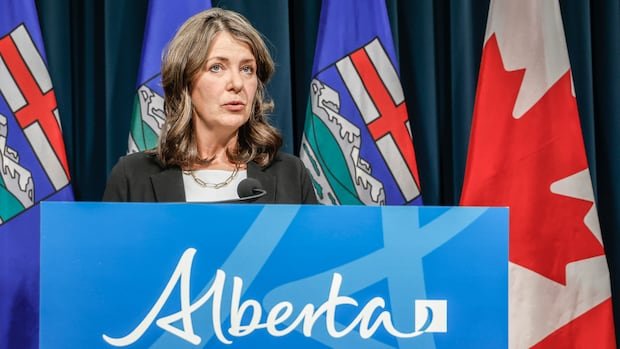Some of the premier’s latest mandate letters, outlining the priorities of Alberta’s health ministers, are reviving concerns that the government is paving the way for even greater provision of private health care.
In letters published last week, ministers responsible for Primary and Preventive Health Services, and Hospitals and Surgical Health Services, were given marching orders along with their counterparts for Assisted Living and Social Services, as well as Mental Health and Addictions.
“This new era of care will deliver a modern health care system that Albertans can count on,” Premier Danielle Smith said in a news release.
“These mandates align all parts of Alberta’s health network to strengthen preventive and frontline care, reduce wait times and make a real difference in every corner of the province.”
The priorities have been set as the Alberta government moves forward with its health care reform, which has divided health care delivery into four separate ministries.
MRIs, CT scans
Primary and Preventive Health Services Minister Adriana LaGrange is mandated to “pass legislation that allows Albertans to have more choice and access to preventive health services, including elective testing, screenings and other diagnostic services.”
With my new mandate letter in hand, I am focused on making Alberta’s healthcare system more accessible, responsive and patient-centered for all.
I will continue to take action and ensure that all Albertans have access to the care they need, when and where they need it. pic.twitter.com/jadFdj0Ouc
This is a key concern for Chris Gallaway, executive director of Friends of Medicare.
“We’re very concerned when they talk about it. We’re not sure what new legislation would be required unless it allows private, for-profit testing and diagnostics to have a grip on the health care system,” he said.
Fiona Clement, a health policy expert at the University of Calgary, said the intent is not entirely clear, but could signal a move to increase private provision of publicly funded diagnostic services.
“If that’s the direction, I’m concerned,” said Clement, head of the community health sciences department at the Cumming School of Medicine, pointing to the Alberta situation. failed attempt to privatize laboratory services with Dynalife.
“We already have some experience in creating private surgical facilities and laboratory facilities and none of those experiences went well,” Clement said.
Reading between the lines of mandate letters sent to four ministers in charge of health care in Alberta, some experts fear the directives could signal a move toward greater privatization.
LaGrange was not available for an interview. In a statement, his press secretary told CBC News that providing more options is part of the government’s broader work to strengthen access and reduce pressure on the public system.
“The Alberta government is committed to maintaining a strong publicly funded health system,” Maddison McKee said in the emailed statement.
“Waiting times for care are too long and we are working to provide more services and increase access.”
The statement said legislation to allow more people to get elective services could include MRIs or CT scans.
Surgeries
Matt Jones, Minister responsible for Hospital and Surgical Health Services, is tasked with “fully implementing a competitive activity-based funding model for insured surgical services to reduce waiting times, improve patient experience and deliver better value to taxpayers”.
Dr. Brian Wirzba, president of the Alberta Medical Association (AMA), said the mandate letters raise more questions than they answer.
“I think there are a lot of things that could certainly open the door to more private care,” he said, adding that doctors want to hear more details about the government’s plans.
According to Wirzba, the AMA sees room for publicly funded and privately provided care (such as procedures offered at licensed surgical centers) within a well-funded and supported system.
“But we need transparency,” he said. “We need to make sure the results are consistent. And we need to make sure that the types of surgeries that affect life and limb… “The kind of care you need at three in the morning is still being provided.”
He said the letter does not address concerns that Alberta’s traditional hospital system is losing staff to licensed surgical facilities.
“We have seen challenges in keeping operating rooms open as doctors, nurses and respiratory technicians move from one care facility to another,” he said.
This directive comes at a time when licensed surgical facilities are under intense scrutiny due to a political controversy that includes accusations of conflicts of interest.
I am pleased to share that I have received a mandate letter to ensure that all Albertans have access to patient-centered hospital and surgical care.
Our work will include helping patients access the most appropriate care while improving emergency medical services, urgent care, emergency department flow and… pic.twitter.com/WpCprbGFW5
According to Clement, activity-based financing occurs when facilities are paid a fixed price for a service, regardless of how the case develops.
“If you’re really innovative and there’s a way to safely limit your time in the operating room, make sure the patient goes home faster, and get the person out of the hospital into the community more quickly and safely, then more of the payment … will be available for other things,” he said.
But he said strong accountability measures are key.
“One thing that happens in the United States with this type of financing model is that they discharge patients … before they are ready because there is a structure that motivates you to make everything as efficient as possible,” he said.
“And without those strong barriers of quality and accountability, in some cases, those decisions can be made without the patient being the center of them.”
Jones was not available for an interview.
In a statement emailed to CBC News, its press secretary, Kyle Warner, said the system will reward efficiency by ensuring funding follows the patient and not the provider.
“The approach is provider-neutral. If a public hospital can perform more surgeries, it will receive more funding, and the same applies to other qualified providers.”
He said safeguards are being built in to ensure patients’ needs are met and to address problems known as “skimming,” where providers choose patients with the lowest expected treatment costs.
Vaccines
The premier is also directing LaGrange to review government policy to ensure free vaccines are targeted to people who are “scientifically proven to be at substantial risk of adverse health outcomes if they remain unvaccinated.”
LaGrange is also expected to explore the possibility of funding additional vaccines for at-risk groups.
This comes at a time when the government has been criticized for its decision to charge most Albertans for the COVID-19 vaccine this fall.
LaGrange’s press secretary did not answer whether the government plans to further defund vaccines.
“The goal is to ensure publicly funded vaccines are targeted to populations most at risk for severe disease and to explore opportunities to expand coverage of additional vaccines that could benefit Albertans,” McKee said.
Other directives include publishing wait times for common surgeries, improving access to care and addressing staffing shortages.
Ministers are also tasked with working together on health issues that may fall under the purview of multiple health ministries, including transferring patients who need alternative levels of care out of hospitals.









